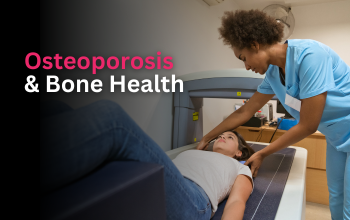The Arthritis Newsletter
Fall 2012Creaky Knees
Written by: Sheila Kerr
 I have to make choices every day about how to live with Osteoarthritis (OA), a disease of joint cartilage and surrounding tissues. You would think that I am a senior, but I am in my mid 50’s and among a growing number of middle aged OA sufferers. How did this happen? As with most things there are a multitude of factors. In my case, I tore my anterior cruciate ligament playing sports when I was 13 and previous joint injury predisposes you to OA. I also have a family history of OA, so I’m a member of the unlucky gene club.
I have to make choices every day about how to live with Osteoarthritis (OA), a disease of joint cartilage and surrounding tissues. You would think that I am a senior, but I am in my mid 50’s and among a growing number of middle aged OA sufferers. How did this happen? As with most things there are a multitude of factors. In my case, I tore my anterior cruciate ligament playing sports when I was 13 and previous joint injury predisposes you to OA. I also have a family history of OA, so I’m a member of the unlucky gene club.
I lead an active lifestyle: hiking, biking, walking, and kayaking but now, pain and joint stiffness are easier to trigger with my daily activities. I am determined to learn how to live with this chronic condition, but I wonder what my best management strategies are?
So what do I take for my OA?
I take time to visit my doctor to rule out inflammatory arthritis, which needs early, aggressive medical treatment to prevent joint deformity and disability.
I take time to get educated about the best management strategies. I head to the internet and type “osteoarthritis” into a Google search; I get 17 million results! How do I know what management strategies are research evidence-based? I look for quality information from websites that end in “.org” or “.edu” which represent educational institutions and non-profit organizations. I am curious about the latest research and find it at the Arthritis Research Centre of Canada’s site.
I take a walk. Low impact activities like walking, swimming and bike riding can be good choices. Exercise can reduce joint pain and helps to maintain joint function and health. Recent research has found that weak quadriceps muscles are a risk factor for the progression of joint damage. I ask an expert in arthritis and exercise, such as a physical therapist, about what activities are best for my particular problems.
I take seriously a decision to set health goals that are achievable, I take time to assess what is working and what is not working, then revise my goals accordingly. What techniques do I use? Well, thinking about what motivates me, and remembering examples where I have changed situations, helps me recall techniques I have successfully used in the past. Collaborating with my health care provider provides me with support and encouragement.
I take care to protect my joints. Pacing activities – keeping active, but not overdoing it; being active but protecting my joints from further damage. If I were bow legged or knock kneed, shoe wedges could help reduce joint damage in knee OA. If my pain and joint damage were more severe, a cane would reduce joint loads.
I take time to build a network that will support my active, healthy lifestyle – inviting friends to participate in weekly walks or trips to the gym. At the gym I focus on low impact strengthening and cardio as well as range of motion exercises.
I take off some weight – every pound adds extra stress to my joints. Surrounding myself with others who are committed to a similar goal makes it easier.
I take my disease seriously. Early management of arthritis is thought to delay progression. Talking to the older generation about the impact OA has had on their quality of life provides motivation to adopt prevention strategies.
I take care not to use the possibility of future joint replacements as an excuse to avoid following effective management strategies now. Joint replacements tend to wear out over time, so because I am middle aged, I focus on delaying progression of symptoms through lifestyle changes.
I take action and develop a plan to reduce pain – talking to health care providers about strategies such as medications, ice, heat, exercise, and distraction such as music or pleasurable activities.
OA is not a normal part of aging, as 57% of Canadians over 65 don’t have it. There is no cure for arthritis, even though arthritis affects 16 percent of the Canadian population over the age of 15. Considering the massive amount of pain and suffering, it is disappointing to note that arthritis research is grotesquely under-funded—-although arthritis affects fully 16 percent of the Canadian population over 15 years of age, it receives only 2 percent of all federal research funding.
We need more answers, more research and more strategies on how to limit the impact of OA on our lives. To learn “the latest” from the researchers at the Arthritis Research Centre of Canada about managing your OA, register for the upcoming Reaching Out with Arthritis Research (ROAR) public event at www.arthritisresearch.ca/ROAR





















































